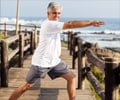Boosting exercise to as much as five hours a week may protect against hypertension in midlife - particularly if it is sustained in one's thirties, forties and fifties.

‘Exercise lowers blood pressure. So, people of middle age should concentrate on exercise as a tool to prevent cardiovascular disorders.’
Read More..




In the study publishing in American Journal of Preventive Medicine, 5,000 adults ages 18 to 30 for 30 years were studies. The participants were asked about their exercise patterns, medical history, smoking status and alcohol use. Blood pressure and weight were monitored, together with cholesterol and triglycerides.Read More..
The 5,115 participants had been enrolled by the Coronary Artery Risk Development in Young Adults (CARDIA) study and came from urban sites in Birmingham, Ala., Chicago, Minneapolis and Oakland, Calif. Approximately half the participants were Black (51.6 percent) and the remainder were White. Just under half (45.5 percent) were men.
Among the four groups, Black men were found to be the most active in early adulthood, exercising slightly more than White men and significantly more than Black women and White women.
But by the time Black men reached age 60, exercise intake decreased from a peak of 560 exercise units to around 300 units, the equivalent to the minimum of two-and-a-half hours a week of moderate intensity exercise recommended by the U.S. Department of Health and Human Services.
This was very less exercise compared to White men (approximately 430 units) and slightly more than White women (approximately 320 units).
Advertisement
"Although Black male youth may have high engagement in sports, socio-economic factors, neighborhood environments, and work or family responsibilities may prevent continued engagement in physical activity through adulthood," said first author Jason Nagata, MD, of the UCSF Division of Adolescent and Young Adult Medicine. Additionally, Black men reported the highest rates of smoking, which may preclude physical activity over time, he noted.
Advertisement
Rates of hypertension mirrored this declining physical activity. Approximately 80-to-90 percent of Black men and women had hypertension by age 60, compared with just below 70 percent for White men and 50 percent for White women.
"Results from randomized controlled trials and observational studies have shown that exercise lowers blood pressure, suggesting that it may be important to focus on exercise as a way to lower blood pressure in all adults as they approach middle age," said senior author Kirsten Bibbins-Domingo, MD, PhD, of the UCSF Department of Epidemiology and Biostatistics.
"Teenagers and those in their early twenties may be physically active but these patterns change with age. Our study suggests that maintaining physical activity during young adulthood - at higher levels than previously recommended - may be particularly important."
17.9 percent of participants who had moderate exercise for at least five hours a week during early adulthood, researchers found that the likelihood of developing hypertension was 18 percent lower than for those who exercised less than five hours a week. The likelihood was even lower for the 11.7 percent of participants who maintained their exercise habits until age 60.
Patients should be asked about physical activity as they are routinely checked for blood pressure, glucose and lipid profiles, obesity and smoking, Nagata said, and intervention programs should be held at schools, colleges, churches, workplaces and community organizations.
Black women have high rates of obesity and smoking, and low rates of physical activity, he said, and should be an important group for targeted intervention.
"Nearly half of our participants in young adulthood had suboptimal levels of physical activity, which was significantly associated with the onset of hypertension, indicating that we need to raise the minimum standard for physical activity," Nagata said.
"This might be especially the case after high school when opportunities for physical activity diminish as young adults transition to college, the workforce and parenthood, and leisure time is eroded."
Source-Medindia












